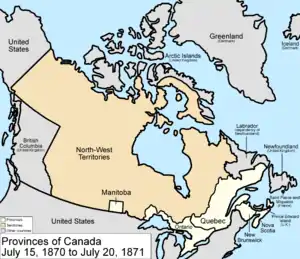Deed of Surrender
The Deed of Surrender or Rupert's Land and North-Western Territory Order is an 1870 British order in council that transferred ownership of Rupert's Land and the North-Western Territory from the United Kingdom to the newly created Dominion of Canada. The Deed ended just over 200 years of Hudson's Bay Company (HBC) control over Rupert's Land and began western Canadian expansion. While the Deed of Surrender was actually only a schedule in the order, the name "Deed of Surrender" is generally understood to refer to the document as a whole. Often confused with Rupert's Land Act 1868, the deed is different as the act only expressed that the United Kingdom and Canada permitted the transfer, but did not settle on the details of exchange with HBC, which were outlined in the Deed of Surrender.


| Deed of Surrender | |
|---|---|
| Queen-in-council | |
| |
| Territorial extent | Rupert's Land, North-Western Territory, Canada |
| Enacted by | Queen-in-council |
| Royal assent | June 23, 1870 |
| Commenced | July 15, 1870 |
| Status: In force | |
History
On May 2, 1670, King Charles II of England granted the HBC a royal charter for "the sole Trade and Commerce of all those Seas, Streights, Bays, Rivers, Lakes, Creeks, and Sounds, in whatsoever Latitude they shall be, that lie within the entrance of the Streights commonly called Hudson's Streights... which are not now actually possessed by any of our Subjects, or by the Subjects of any other Christian Prince or State... and that the said Land be from henceforth... called Rupert's Land".[1] In addition to the grant of commercial rights, the Charter also stated that the grant was "together with all the Lands and Territories upon the Countries, Coasts and Confines of the Seas, Bays, Lakes, Rivers, Creeks, and Sounds aforesaid, that are not already actually possessed," and including "all mines Royal".[1] The Supreme Court of Canada has held that the grant gave the Company ownership of the land and precious minerals within Rupert's Land.[2][3] Due to the extent of the lands granted not truly being known at the time, in 1821, the British Parliament further extended the company's domain to the North-Western Territory as well with the passage of "An act for regulating the fur trade, and establishing a criminal and civil jurisdiction within certain parts of North America".[4]
In 1867, with Confederation, the new Dominion of Canada sought to expand westward. In that same year, Canada's Parliament expressed this desire to the United Kingdom and soon after entered into talks with the HBC to arrange for the transfer of the territory.[5] These talks resulted in the Deed of Surrender, which was part of an order-in-council by the United Kingdom titled "Rupert's Land and North-Western Territory - Enactment No. 3: Order of Her Majesty in Council admitting Rupert's Land and the North-Western Territory into the union, dated the 23rd day of June 1870". The Deed was approved and issued on June 23, 1870, and took effect on July 15, 1870.[6] The Province of Manitoba, the first new province to join Confederation, was created on the same day.
References
- "Text of HBC's Royal Charter". HBC Heritage. Retrieved February 14, 2020.
- Reference re Precious Metals in certain lands of the Hudson's Bay Co., [1927] SCR 458, at p. 466.
- Marjorie L. Benson and Don Purich, "Real Property", Encyclopedia of Saskatchewan, Canadian Plains Research Centre, University of Regina, 2006.
- An act for regulating the fur trade, and establishing a criminal and civil jurisdiction within certain parts of North America. London, England. 1821.
- "Correspondence relating to Surrender of Rupert's Land by Hudson's Bay Company and Admission into Dominion of Canada". House of Commons Papers. 43.
- Rupert's Land and North-Western Territory - Enactment No. 3. Government of Canada, Department of Justice. Retrieved February 14, 2020.